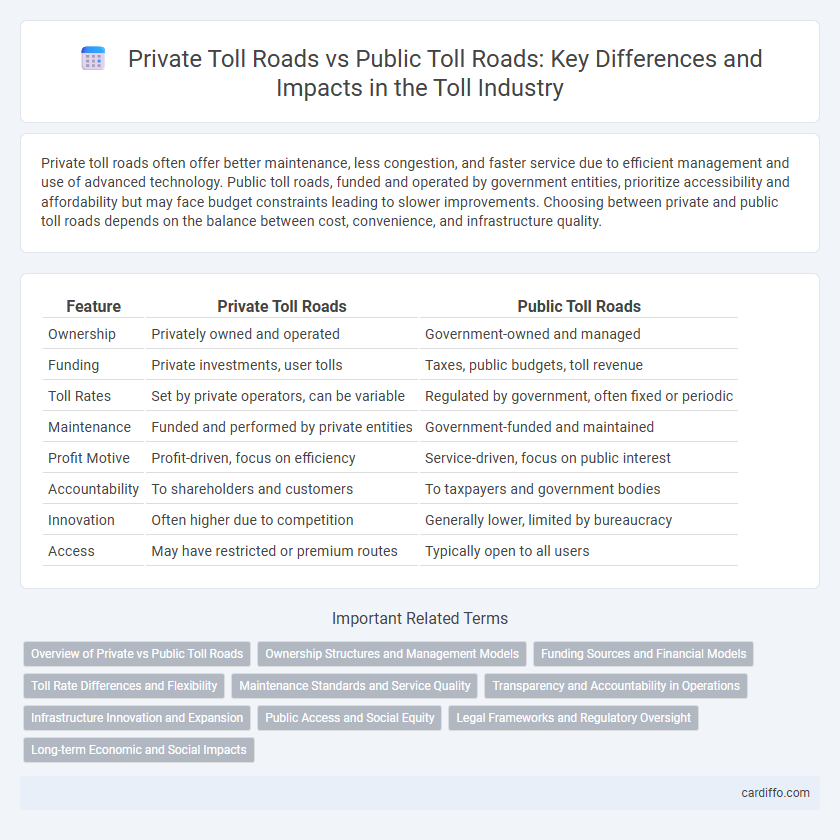Private toll roads often offer better maintenance, less congestion, and faster service due to efficient management and use of advanced technology. Public toll roads, funded and operated by government entities, prioritize accessibility and affordability but may face budget constraints leading to slower improvements. Choosing between private and public toll roads depends on the balance between cost, convenience, and infrastructure quality.
Table of Comparison
| Feature | Private Toll Roads | Public Toll Roads |
|---|---|---|
| Ownership | Privately owned and operated | Government-owned and managed |
| Funding | Private investments, user tolls | Taxes, public budgets, toll revenue |
| Toll Rates | Set by private operators, can be variable | Regulated by government, often fixed or periodic |
| Maintenance | Funded and performed by private entities | Government-funded and maintained |
| Profit Motive | Profit-driven, focus on efficiency | Service-driven, focus on public interest |
| Accountability | To shareholders and customers | To taxpayers and government bodies |
| Innovation | Often higher due to competition | Generally lower, limited by bureaucracy |
| Access | May have restricted or premium routes | Typically open to all users |
Overview of Private vs Public Toll Roads
Private toll roads are typically operated by corporations or special private entities, funded through private investment and often designed to deliver faster, more efficient routes with advanced infrastructure technology. Public toll roads are managed by government agencies or public authorities, focusing on broader accessibility and infrastructure development funded by taxpayer dollars and toll revenue. The key difference lies in ownership and management, impacting toll rates, maintenance priorities, and long-term investment strategies.
Ownership Structures and Management Models
Private toll roads are typically owned and operated by corporations or public-private partnerships where revenue generation and efficiency drive management decisions. Public toll roads are managed by government agencies or authorities funded by taxpayer revenue, focusing on public service and infrastructure maintenance. Ownership structures impact toll rates, investment in road quality, and long-term operational strategies significantly, with private models emphasizing profitability and public models prioritizing accessibility.
Funding Sources and Financial Models
Private toll roads primarily rely on private investments, user fees, and sometimes public-private partnerships (PPPs) to fund construction and maintenance, enabling faster project delivery with less public debt. Public toll roads are predominantly financed through government bonds, tax revenues, and federal or state funds, often aiming to support broader transportation infrastructure goals while balancing public accessibility. Financial models for private toll roads emphasize profitability and return on investment, whereas public toll roads focus on cost recovery and long-term public benefit.
Toll Rate Differences and Flexibility
Private toll roads typically implement higher toll rates due to the need to recover construction and maintenance costs while generating profit, whereas public toll roads often set lower rates subsidized by government funding. Flexibility in toll pricing on private roads allows dynamic adjustment based on traffic demand, time of day, or vehicle type, contrasting with the generally fixed and regulated toll rates found on public roads. This pricing strategy on private toll roads helps manage congestion more efficiently and enhances revenue optimization compared to their public counterparts.
Maintenance Standards and Service Quality
Private toll roads typically maintain higher maintenance standards due to dedicated funding and profit-driven incentives, resulting in smoother pavement and prompt repairs. Public toll roads rely on government budgets, which can cause variability in service quality and slower response times to infrastructure issues. Consistent upkeep and enhanced customer services are more frequently observed in private toll operations compared to their public counterparts.
Transparency and Accountability in Operations
Private toll roads often feature proprietary data management systems that limit public access to operational transparency, whereas public toll roads typically adhere to established government-reporting standards ensuring greater accountability. Public toll roads provide detailed usage statistics, financial reports, and maintenance schedules that are accessible via government portals, promoting stakeholder trust. This transparency supports regulatory oversight and public input, which are generally less prominent in private toll road operations focusing on profitability.
Infrastructure Innovation and Expansion
Private toll roads often drive infrastructure innovation by leveraging advanced technologies such as electronic toll collection and dynamic pricing models to optimize traffic flow and revenue generation. Public toll roads focus on expansion projects funded through government budgets and public-private partnerships, aiming to enhance regional connectivity and reduce congestion. Investment in smart infrastructure and sustainable construction methods on both types promotes safer, more efficient transportation networks.
Public Access and Social Equity
Public toll roads offer broader access by allowing all vehicles to use the infrastructure regardless of membership or payment plans, which enhances social equity by providing essential connectivity to underserved communities. In contrast, private toll roads often restrict access through exclusive pricing or membership models, potentially limiting mobility for lower-income users. Ensuring public access on toll roads supports equitable transportation by reducing disparities in travel options and economic opportunities.
Legal Frameworks and Regulatory Oversight
Private toll roads operate under contractual agreements with government entities, often governed by public-private partnership (PPP) frameworks that specify toll rate adjustments, maintenance responsibilities, and concession durations. Public toll roads are regulated directly by governmental agencies, ensuring compliance with statutory toll rate caps and infrastructure standards under comprehensive transportation laws. Regulatory oversight for both models includes monitoring toll collection accuracy, safety regulations, and periodic audits to protect users' rights and maintain transparent revenue management.
Long-term Economic and Social Impacts
Private toll roads often generate higher initial revenue through user fees, enabling faster infrastructure development and maintenance without immediate public funding. Public toll roads typically reinvest collected tolls into broader transportation networks, potentially ensuring more equitable access and long-term regional economic growth. Studies show private roads may lead to cost efficiencies but risk prioritizing profit over social equity, while public toll roads support inclusive mobility and sustained community benefits.
Private toll roads vs public toll roads Infographic

 cardiffo.com
cardiffo.com